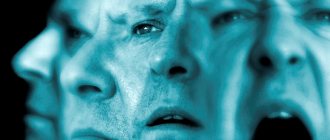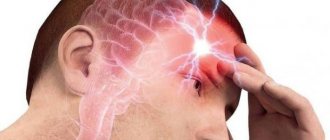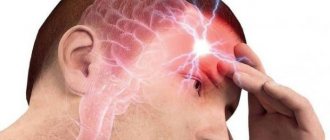]Male dystonia at other ages can be caused by:
- feeling of psychological exhaustion of the body;
- sleep problems;
- unbalanced diet or lack of vitamins;
- lack of intimate life;
- increased physical activity;
- human sleep disturbance;
- the appearance of fatigue and apathy;
- pressure;
- frequent respiratory diseases;
- problems with blood circulation;
- dyspnea;
- disturbances in the functioning of the cardiovascular system.
- weakness;
- decreased performance;
- stress.;
- psychological trauma;
- rapid heartbeat.
Where did VSD come from? This is exactly the question we want to answer today. You can read comments from patients who have already encountered this disease and found results on our website. Some groups of people suffer from vegetative-vascular dystonia from birth. In this state, they painfully tolerate heat and cold, during the experience they begin to turn red, cold extremities and trembling are observed. In children it manifests itself as urinary incontinence. In women, for example, it manifests itself in sharply different types of vegetative crises.
Vegetative-vascular dystonia, symptoms and its treatment in men
One of the main reasons for its appearance is heredity and arrhythmia. For example, in children, the diagnostic method considers it as a hereditary disease that was passed on from parents. Stressful situations during pregnancy can not only negatively affect the baby’s personality, but also affect the nervous activity of the brain and cause depression. There is evidence that the emotional formation of a child’s body can provoke the development of internal disease. The common cause of development in a teenager can be: conflict situations with parents or peers, constant stress overexertion, dizziness, chronic pathologies, passive lifestyle, lack of sports in the teenager’s life, tachycardia.
In an adult, it may begin to develop due to a hormonal surge. For this reason, it occurs many times more often in women than in the stronger sex. Carrying a child, menopause, the prenatal period - all these are turning points in the life of every woman that can provoke the effects of the disease. The most dangerous period is pregnancy. Another reason for the development may be excess weight and changes in blood pressure. With the addition of kilograms, additional stress begins to be placed on the cardiac system. Excess weight can also cause development among men.
In the 21st century, a huge number of diseases are associated with the autonomic nervous system. Therefore, many people are interested in symptoms and signs. Do not prescribe medications for yourself!
Already by the name you can determine that malfunctions begin in the body. In another way, it is called neuro-circular. But among the common people it is customary to use the old name. As statistics show, a tendency to this disease is observed in 100% of the world's population. Signs and symptoms in an adult and a child are practically the same.
Modern views on the treatment of vegetative dystonia syndrome in children
Autonomic dystonia syndrome (VDS) is one of the most common childhood diseases. It is known that when visiting a pediatrician, SVD accounts for 50–75% of the number of patients with non-infectious pathologies. In this case, patients may experience changes in various organs and systems that are functional in nature. In this way, dystonia is fundamentally different from other diseases, which should not be a reason for reassurance, since the transition of VDS into such psychosomatic diseases in adults as coronary heart disease, hypertension, bronchial asthma is possible. The lack of adequate therapy can lead to a deterioration in the patient's condition. In this regard, it is necessary to search for new effective methods of treating children with VDS.
Typically, treatment of a patient with SVD is carried out over a long period of time. In this case, it is very important to take into account the nature of autonomic disorders (the predominance of activity of the sympathetic or parasympathetic parts of the autonomic nervous system), the severity of clinical manifestations, as well as the psycho-emotional characteristics of the child’s personality. Preference in the treatment of children with VDS should be given to non-drug methods. This is sufficient for mild cases of SVD. In severe cases, drug therapy is also used. At the same time, chronic foci of infection and concomitant diseases are treated.
Therapy should begin with normalizing the daily routine: it is very important that night sleep is at least 8–10 hours, and that the child walks in the fresh air for at least 2–3 hours a day. When constructing classes, it is advisable to alternate physical and mental stress. It is necessary to eliminate physical inactivity, limit television viewing to 1 hour per day, as well as computer work, which should be dosed taking into account the child’s age.
Physical education classes. Children with SVD should do morning exercises. Swimming, skiing, skating, measured walking, playing table tennis, and badminton have a beneficial effect on patients. Group sports (football, basketball, volleyball), as well as boxing, wrestling, and kickboxing are not recommended.
Nutrition. A child with VDS should receive adequate nutrition with sufficient amounts of minerals and vitamins. Children with increased sympathoadrenal activity and labile arterial hypertension need to limit the consumption of table salt, tea, and coffee. It is advisable to exclude smoked meats, spicy foods, and chocolate from the diet. Children with increased parasympathetic activity and arterial hypotension are recommended to eat food containing a sufficient amount of liquid, as well as marinades, tea, coffee (preferably with milk), chocolate and chocolate candies, kefir, buckwheat porridge, peas. It is advisable for children with SVD to take honey at night for 2–3 months, as well as various juices, infusions, compotes from sea buckthorn, viburnum, rose hips, rowan, carrots, lingonberries, chokeberry, raisins, dried apricots.
Psychotherapy. An important place in the treatment of children with VDS should be given to individual rational psychotherapy aimed at correcting the internal picture of the disease with a reorientation to non-drug methods of self-regulation. At the same time, it is very important that the attending physician inspires confidence not only in the child, but also in his parents. You can often see a good therapeutic effect by convincing the patient only to change his lifestyle, diet, and exercise.
Water procedures. Typically, the following water procedures are effective for children with SVD: swimming, circular shower, sauna, medicinal baths. Balneotherapy should be carried out depending on the characteristics of autonomic disorders. For children with increased sympathetic activity, baths with the addition of sedative herbs are indicated; for vagotonia, salt pine, narzan, radon baths, dousing, and rubbing with cold water are recommended.
Physiotherapeutic treatment. For SVD, galvanization using the reflex-segmental technique, paraffin, and ozokerite for the cervical-occipital region are widely used. The choice of technique should be made taking into account the direction of the initial autonomic tone. For vagotonia, electrophoresis on the collar zone with a 5% calcium chloride solution, 1% caffeine solution or 1% mesatone solution is indicated. For sympathicotonia, electrophoresis with a 2% aminophylline solution, 2% papaverine solution, and 4% magnesium sulfate solution is used.
Massage. For vagotonia, especially when combined with a decrease in blood pressure, a general massage is prescribed, as well as a massage of the calf muscles, hands and cervical-collar area; with a predominance of sympathetic tone - massage in the areas of the spine and cervical-collar region.
Drug therapy. If the therapeutic and recreational measures described above are insufficiently effective, drug therapy is prescribed. It is advisable to begin drug treatment with herbal medicine. For children with increased excitability and anxiety, it is recommended to prescribe herbal infusions that have a sedative effect: sage, hawthorn, valerian, motherwort, St. John's wort (Table 1). Courses of treatment are usually long - for 3–12 months. The drugs must be alternated every 2–4 weeks (with a two-week break between courses).
In addition to tinctures and extracts, various types of tea can also be used from herbal remedies. Of the valerian preparations, “valerian tea” has proven itself best: 1 tbsp. Brew a spoonful of crushed valerian root with one glass of boiling water in the evening, cover with a saucer and the next day take the infusion in 3-4 doses. In the same way, motherwort tea is prepared, which has even greater calming properties than valerian. In case of acute neurotic reactions, a “valerian cocktail” can be used as a fast-acting “fire extinguisher”: 5–15 ml of valerian tincture, i.e. 1 teaspoon, dessert or tablespoon, half with water. The sedative effect of tableted valerian extract is less convincing.
If the calming effect of herbal medicines is insufficient, anxiolytics and antipsychotics are used in the treatment of children with SVD (Table 2).
The main target of action of neuroleptics and anxiolytics are the structures of the limbic-reticular complex, in which the higher vegetative and emotional centers are concentrated. The close connection between mental and autonomic functions carried out by the limbic system makes it possible to understand why these drugs, while reducing emotional excitability, simultaneously have a normalizing effect on autonomic-visceral disorders that accompany VDS.
When prescribing tranquilizers, it is necessary to take into account the characteristics of the patient’s psycho-emotional state and the direction of autonomic dysfunction (vagal or sympathicotonia). For children with increased levels of anxiety and sleep disturbances, tranquilizers with a pronounced sedative effect are indicated: seduxen (Sibazon, Relanium, Diazepam), Phenazepam, Tazepam, Atarax. In case of a hyposthenic neurotic state, arterial hypotension, drugs with a moderate activating effect are prescribed - “daytime tranquilizers” (Grandaxin, medazepam), which are usually given in two doses - morning and afternoon. It is important to consider that for SVD of the sympathicotonic type, it is advisable to use Seduxen (1 tablet - 0.005 g), Tazepam (1 tablet - 0.01), Phenazepam (1 tablet - 0.5 and 1 mg). For children with SVD of the vagotonic type, Amizil (1 tablet - 1 mg or 2 mg) is indicated; for the mixed version of SVD - Bellaspon (1-3 tablets per day), Rudotel (1 tablet - 0.01 g), Grandaxin (1 tablet - 0.05 g). The duration of tranquilizer prescriptions is no more than 4–6 weeks, repeated courses are possible.
Neuroleptics are indicated for children with acute and chronic anxiety, motor restlessness, the presence of tics, hypochondria, fears, as well as persistent pain. They reduce the reaction to external stimuli, have a vegetotropic effect, and are recommended for use when tranquilizers are ineffective. The most commonly used drugs from this group are Frenolone at a dose of 5–15 mg/day, thioridazine (Melleril, Sonapax) for preschool children at a dose of 10 to 20 mg/day, for school children at a dose of 20–30 mg/day, and Teralen at a dose of 5–15 mg/day. Frenolone and Sonapax give a good effect for cardialgia. Teralen also has antihistamine properties.
If necessary, antipsychotics can be combined with anxiolytics.
Drugs that improve metabolic processes in the central nervous system - neurometabolic stimulants . They are indicated for children with severe manifestations of VDS. Neurometabolic stimulants not only have a positive effect on metabolic processes and blood circulation in the brain, but also stimulate redox processes, enhance glucose utilization, improve the body’s energy potential, increase the resistance of brain tissue to hypoxia, help improve memory, and facilitate the learning process. For this purpose, you can prescribe Nootropil (0.4–0.6 mg/day), Encephabol (0.1–0.2 mg/day), Aminalon (0.5–1 g/day), Pantogam (0.5 –0.75 g/day), Phenibut (0.5–0.75 g/day), glycine (0.2–0.3 g/day). Along with these drugs, glutamic acid and Cerebrolysin 1 ml intramuscularly are used (course of treatment - 10-15 injections). Treatment with these drugs is carried out 2-3 times a year.
Children with vagotonic SVD are prescribed herbal psychostimulants that increase the activity of the sympathetic nervous system. For this purpose, you can use caffeine, tincture of ginseng, Schisandra chinensis, eleutherococcus, Rhodiola rosea, zamanikha, pantocrine. All these drugs are prescribed at the rate of 1-2 drops per 1 year of life in the first half of the day: 2 times a day 30 minutes before meals for 1-2 months, alternating them with each other (with breaks of 2-3 weeks).
For persistent headaches and intracranial hypertension, courses of Diacarb and diuretic herbs are indicated. To improve microcirculation, Trental, Cavinton, Vinkapan are prescribed.
Currently, in the treatment of SVD, drugs have begun to be used that contain coenzymes, microelements and vitamins in isolated form or in combination: Coenzyme Q10, L-carnitine, Betacarotene, calcium hypochlorite, calcium lactate, calcium phosphate, Magne B6, Multi- Tabs and Multi-Tabs with beta-carotene.
It is important to consider that for sympathicotonia, preference should be given to potassium preparations and vitamin B1, while for vagotonia - calcium, phosphorus, vitamins B6, C.
Treatment of arterial hypertension. For arterial hypertension, basic therapy is indicated, including vascular and nootropic drugs. For this purpose, you can prescribe Oxibral (2.5 ml of syrup 3 times a day), Vinpocetine (1 tablet - 5 mg), Cavinton (1 tablet - 5 mg), Cinnarizine (1 tablet - 25 mg). If treatment is ineffective, antihypertensive drugs are prescribed. It is important in the treatment of patients with arterial hypertension to individually select drugs for a particular person. For stable arterial hypertension and a hyperkinetic type of blood circulation (tachycardia, a predominant increase in systolic blood pressure), the administration of small doses of β-blockers is indicated: atenolol - 0.7 mg/kg once a day, propranolol (Obzidan, Inderal) - 0.5 mg/kg kg 3-4 times a day. In case of hypokinetic type of blood circulation (bradycardia, increase in predominantly diastolic blood pressure), treatment begins with the prescription of diuretics (Hypothiazide, Triampur compositum). If there is no effect, the prescription of the angiotensin-converting enzyme inhibitor captopril (0.5 mg/kg 3 times a day) is indicated. In pediatric practice, the long-acting drug enalapril (0.02 mg/kg once a day) is often used.
Relief of hypertensive crises. First of all, it is necessary to create the most calm environment possible. In order to reduce blood pressure in a child with VDS, you can prescribe sedatives (Seduxen - 1 tablet - 5 mg or 1-2 ml IV), diuretics (Furosemide, Lasix), potassium supplements (Panangin - 2 tablets), selective β - adrenergic blocker atenolol at a rate of 0.7 mg/kg.
Treatment of vegetative paroxysms is quite difficult, since crises have a circadian pattern and are strictly individual. The predominance of activity of one or another part of the autonomic nervous system during a crisis may be compensatory; By suppressing this department, you can aggravate and intensify the crisis. It is not so much the treatment of the crisis itself that is important, but complex and long-term therapy during the interictal period.
For sympathoadrenal paroxysms in children, tranquilizers, sedatives, and β-blockers are used. It is advisable to prescribe a β-blocker for another 4–5 days after the crisis has stopped, possibly in combination with sedative medications. If the patient has repeated sympathoadrenal crises and a connection has been identified between their occurrence and psycho-emotional stress, then a β-blocker can be prescribed in a small dose for a longer period of time. It is necessary to eliminate the provoking factor and give the patient a course of psychotherapy. For children with recurring parasympathetic crises, it is advisable to undergo a long course of treatment (1–2 months) with one of the belladonna preparations. For this purpose, you can use Bellaspon, Bellataminal, etc. They are usually prescribed at night (1/2–1 tablet) depending on age. Against this background, treatment for SVD should be continued.
If a child has a vegetative paroxysm, it is necessary to determine the characteristics of its course (vagoinsular, sympathoadrenal or mixed), and then, taking this into account, provide the necessary assistance (Table 3).
In conclusion, it should be said that the relief of vegetative crises in children, as well as the treatment of SVD, requires an individual approach with the selection of appropriate methods and drugs. Even with adequate therapy for VDS, monitoring the effectiveness of therapy is necessary, since paradoxical reactions can be observed, since vagotonia or sympathicotonia in their pure form practically does not occur in children. By replacing one treatment method with another, you can achieve a positive therapeutic effect in most cases.
Literature
- Belokon N. A., Kuberger M. B. Heart and vascular diseases in children. In 2 volumes. M.: Medicine, 1985.
- Autonomic dysfunction in children and adolescents (clinic, diagnosis, treatment) // Kozlova L. V., Samsygina G. A., Tsaregorodtseva L. V. et al.: Educational manual. Smolensk, 2003. 80 p.
- Vegetative-vascular dystonia in children (clinic, diagnosis, treatment) // Belokon N. A., Osokina G. G., Leontyeva I. V. et al.: Method. rec. M., 1987. 24 p.
- Belyaeva L. M., Khrustaleva E. K. Functional diseases of the cardiovascular system in children. Minsk: Amalfeya, 2000. 208 p.
- Cardiology of childhood: Textbook / ed. Yu. M. Belozerova, A. F. Vinogradova, N. S. Kislyak and others. Tver, 1995. 266 p.
- Leontyeva I.V. Arterial hypertension in children and adolescents // Lectures for doctors. M., 2000. 62 p.
- Lectures on pediatrics. T. 4. Cardiology / ed. V. F. Demina, S. O. Klyuchnikova, N. P. Kotlukova and others. M., 2004. 412 p.
- Makolkin V.I., Abakumov S.A. Sapozhnikova A.A. Neurocirculatory dystonia (clinic, diagnosis, treatment). Cheboksary: Chuvashia, 1995. 250 p.
- Meshkov A.P. Functional (neurogenic) heart diseases. N. Novgorod: NGMA, 1999. 208 p.
- Practical guide to childhood diseases / ed. G. A. Samsygina, M. Yu. Shcherbakova. T. 3. 735 p.
- Recommendations for the diagnosis, treatment and prevention of arterial hypertension in children and adolescents. M., 2003. 43 p.
- Shvarkov S. B. Modern concept of autonomic disorders and their classification // Pediatrics. 2003. No. 2. P.108–109.
- Tsaregorodtseva L.V. Discussion issues of vegetative dystonia syndrome in children // Pediatrics. 2003. No. 2. P.103–105.
- Tsaregorodtseva L.V. Treatment of vegetative dystonia syndrome // Pediatrics. 2003. No. 2. P. 52–56.
- Encyclopedia of drugs. M.: LLC "RLS-2005", 2004. 1440 p.
- Human Blood Pressure Determination by Sphyqmomanometry / D. Perloff, C. Grim, J. Flack et al. // Circulation. 1993; 88:2460–2467.
- Update on the 1987 Task Force Report on the high blood pressure in children and adolescents, National High Blood Pressure Education Program Working Group on Hypertension Control in Children and Adolescents // Pediatrics. 1996; 98(4, Part 1): 649–658.
L. V. Tsaregorodtseva , Candidate of Medical Sciences, Associate Professor of the Russian State Medical University, Moscow
Prevention and treatment of VSD
To relieve an attack, sedatives such as valerian or peony tincture are often used. These are drugs that have a positive effect on the human nervous system. As a result, vascular tone begins to improve, and the symptoms disappear. A good doctor will not start prescribing you strong sedatives at the first stage of treatment; first of all, he will prescribe you a healthy lifestyle, where there is no place for stress. Complex of treatment and preventive measures:
- no overload on the body;
- proper nutrition;
- time to rest;
- 8 hour sleep;
- having an intimate life with a regular partner;
- climate change.
A healthy lifestyle is an excellent primary treatment and prevention method for male VSD. VSD in men is a type of disease in which both the way to combat it and the following methods of prevention are identical.
Note! You should not try to cope with the disease with the help of those drugs that once helped relatives or friends! Finding the strength to go to the doctor is also a lot of work. Only a qualified specialist can prescribe the correct treatment for vegetative vascular dystonia in men! When the first signs and symptoms of vegetative-vascular dystonia appear, you must immediately contact the clinic!
Symptoms and signs of vegetative-vascular dystonia
Signs of vegetative vascular dystonia in adults are very diverse, these are:
- general weakness, fatigue (both mental and physical), drowsiness during the day
- emotional instability (irritability, anxiety, depressed mood)
— weather sensitivity
- instability of blood pressure (hypertension and hypotension)
- panic attacks (sudden attacks of unreasonable fear, fear of dying, tachycardia, numbness of body parts, feeling of lack of air, etc.)
- headaches, heaviness in the head
- frequent dizziness
– pain in various parts of the body (usually in the neck, back, limbs)
- sleep problems (insomnia, frequent sudden awakenings, nightmares)
- increased sweating
- low-grade fever
And this is only part of the symptoms that can occur with vegetative vascular dystonia in adult women and men. VSD has many faces, and its symptoms are often disguised as cardiac, mental, endocrine and gastric diseases.
Clinical practice shows that signs of vegetative-vascular dystonia occur equally often in both men and women. In addition, vegetative vascular dystonia occurs more often in adults of type A.
“Usually, vegetative-vascular disorder manifests itself in people of type A. These are those people who perform the task assigned to them perfectly to the detriment of their well-being and health - at the expense of sleep and any type of relaxation, sometimes even at the expense of food,” - doctor - neurologist of the Clinical Center for Autonomic Neurology, Alexander Ivanovich Belenko.
VSD in men
From childhood, boys are taught that tears are a sign of weakness. A ban on this method of expression leads to the fact that the only way out is to show aggression. But at the same time, aggression must be exercised carefully.
Teenagers prone to VSD often take out aggression on others, their behavior is alarming, and young people often begin to drink alcohol. In this case, the causes and symptoms are similar to age-related changes in the child’s body and parents simply turn a blind eye to it. If you notice excessive aggression in a child, we recommend that you immediately contact our center for help.
A child who receives excessive care from his parents can also suffer from panic attacks; not only does he not have the opportunity to show aggression, he also cannot express his opinion. Now you are convinced that men have a huge number of ways to develop VSD.
Treatment
There are no treatments for hereditary peripheral neuropathies. However, there are treatments for many other forms. First, the cause of the disease is treated and symptomatic treatment is carried out. Peripheral nerves have the ability to regenerate if the nerve cell itself is preserved. Symptoms can be managed, and addressing the causes of certain forms of neuropathy can often prevent recurrence of damage.
In general, healthy lifestyle choices—such as maintaining an optimal weight, eliminating toxins from entering the body, eating well with adequate vitamins, and limiting or eliminating alcohol intake—can reduce the physical and emotional effects of peripheral neuropathy. Active and passive exercise can reduce cramps, improve muscle elasticity and strength, and prevent muscle atrophy in paralyzed limbs. Various diets may improve gastrointestinal symptoms. Prompt treatment for injuries can help prevent permanent damage. Quitting smoking is especially important because smoking spasms the blood vessels that carry nutrients to peripheral nerves and can worsen neuropathy symptoms. Good nursing skills, such as careful care, of diabetic feet and wounds are essential because these patients have decreased pain sensitivity. Good care can relieve symptoms and improve quality of life and stimulate nerve regeneration.
Systemic diseases often require more complex treatment. Strict control of blood glucose levels has been shown in studies to reduce neuropathic symptoms and help patients with diabetic neuropathy avoid further nerve damage. Inflammatory and autoimmune diseases that lead to neuropathy can be treated in several ways. Immunosuppressants such as prednisone, cyclosporine, or imuran can be very effective. Plasmapheresis, a procedure that clears the blood of immune cells and antibodies, can reduce inflammation or suppress the activity of the immune system. Large doses of immunoglobulins, which function as antibodies, can also suppress abnormal immune system activity. But neuropathic pain is difficult to treat. Moderate pain can sometimes be relieved with analgesics. Some medications (used to treat other conditions) have proven helpful for many patients suffering from severe forms of chronic neuropathic pain. They include Mexilitine, a drug designed to treat irregular heart rhythms (but sometimes causes significant side effects); some antiepileptic drugs, including gabapentin, phenytoin, and carbamazepine; and some types of antidepressants, including tricyclics such as amitriptyline. Injecting a local anesthetic such as lidocaine or using patches containing lidocaine may relieve severe pain. In the most severe cases of pain, the nerves can be surgically destroyed; however, the results are sometimes temporary and the procedure can lead to complications.
Orthotics can help reduce pain and reduce the impact of physical disability. Various arm or leg orthoses can compensate for muscle weakness or relieve nerve compression. Orthopedic shoes can improve gait disturbances and help prevent foot injuries in people with decreased pain perception.
Surgery can often provide immediate relief for mononeuropathies caused by nerve entrapment or compression. Removal of a herniated disc causes decompression of the root. Removing tumors also reduces the impact of tumor tissue on the nerves. Additionally, nerve decompression can be achieved through ligament and tendon release.
Transformation of symptoms in men
Scientists are confident that the predominance of the syndrome in women is associated with social aspects. But even among representatives of the stronger sex, symptoms such as the body’s reaction to weather conditions, headaches, stomach dysfunction, and rapid heartbeat are not uncommon. Most often, representatives of the stronger sex are diagnosed too late. Representatives of the stronger sex are not used to going to the doctor for trifles. Most people use alcoholic beverages as medicine. Drinking alcohol can result in another panic attack. Most often, company is not required in this case, or new acquaintances appear who drag you into binge drinking. Oddly enough, in most cases, alcoholic drinks actually help. But prolonged consumption of alcohol has a detrimental effect on internal organs. Statistics show that 50% of men who were diagnosed with VSD had a tendency to drink excessively.
Diagnostics
Diagnosing peripheral neuropathy can sometimes be difficult due to the variability of symptoms. A complete neurological examination is often required, including: the patient's symptoms, occupation, social habits, the presence of any toxins, the presence of chronic alcoholism, the possibility of HIV or other infectious disease, and a history of relatives with neuropathy, performing tests that can identify the cause of the neuropathy, and conducting examinations to determine the degree and type of nerve damage.
General examination tests and tests may reveal the presence of nerve damage due to systemic disease. Blood tests can diagnose diabetes, vitamin deficiencies, liver or kidney failure, other metabolic disorders, and signs of abnormal immune system activity. Examination of the cerebrospinal fluid, which circulates in the brain and spinal cord, can reveal abnormal antibodies associated with neuropathy. More highly specialized tests can detect blood diseases or cardiovascular diseases, connective tissue diseases, or malignancies. Muscle strength tests showing signs of muscle twitching or fasciculations may indicate motor neuron damage. Assessing the patient's ability to perceive vibration, soft touch, body position (proprioception), temperature and pain sensitivity helps determine damage to sensory fibers of both large and small sensory fibers. Based on the results of a neurological examination, physical examination, and a detailed medical history, additional tests and examinations may be prescribed to clarify the diagnosis.
Computed tomography is an atraumatic, painless study that makes it possible to visualize organs, bone and soft tissue. A CT scan can reveal bone or vascular changes, brain tumors, cysts, herniated discs, encephalitis, spinal stenosis (narrowing of the spinal canal), and other disorders.
Magnetic resonance imaging (NMR or MRI ) can examine the condition of the muscle and its size, reveal the replacement of muscle tissue with fatty tissue, and determine whether there has been a compressive effect on the nerve fiber. MRI machines create a strong magnetic field around the body. Radio waves pass through the body and cause resonance, which can be detected at various angles within the body. The computer processes this resonance effect and converts it into a three-dimensional image.
Electromyography (EMG ) involves inserting a thin needle into a muscle to measure the electrical activity of the muscle at rest and during contraction. EMG tests can help differentiate between damage to the muscle itself and to the nerve fibers. Nerve conduction speed can accurately determine the extent of damage in large nerve fibers, clearly indicating whether symptoms are related to myelin sheath or axon degeneration. During this study, electrical stimulation of the fiber is performed, in response to which a response impulse appears in the nerve. An electrode placed further along the nerve measures the speed of impulse transmission along the axon. Slow transmission rates and impulse blocking typically indicate damage to the myelin sheath, while decreased impulse levels are a sign of axonal degeneration.
A nerve biopsy involves removing and examining a sample of nerve tissue, most often in the lower leg. Although this test can provide valuable information about the extent of nerve damage, it is an invasive procedure that is difficult to perform and can cause nerve damage and signs of neuropathy. In most cases, this procedure is not indicated for diagnosis and may independently cause neuropathic side effects.
Skin biopsy is a test in which a small piece of skin is removed and the endings of nerve fibers are examined. This diagnostic method has advantages over EMG and nerve biopsy when it is necessary to diagnose damage in smaller sensory fibers. Additionally, unlike a conventional nerve biopsy, a skin biopsy is less invasive, has fewer side effects, and is easier to perform.
Preventive measures for men
Determining the forms and nature of the disease is not an easy task. The symptoms resemble banal overwork and lack of rest. More often, diagnosis among representatives of the stronger sex occurs completely by chance. That is why men who experience similar symptoms to vegetative-vascular dystonia should immediately seek help from our clinic. Preventative measures will help prevent further development. As preventive medications and procedures, doctors recommend using amino acids, a tranquilizer, which will help normalize the balance between the sympathetic and parasympathetic departments. They are not only an excellent method of prevention, but also improve the functioning of the heart, restore important processes in the body and help overcome physical work. The effect is observed after a few days. Don't self-medicate! Any drug is prescribed by a doctor after tests! Do not use traditional methods of treatment without consulting a doctor!
Types of vegetative-vascular dystonia:
cardiac type of vegetative-vascular dystonia
Symptoms: tachycardia (rapid heartbeat), arrhythmia (interruptions in the heart), “heart pain,” respiratory arrhythmia and a feeling of lack of air. Interruptions in the functioning of the heart cause a feeling of lack of oxygen. With VSD, pain in the heart area does not become a harbinger of a heart attack and does not affect the heart in any way, as evidenced by the patient’s echocardiogram. To diagnose this type of vegetative-vascular dystonia, the study of heart rate variability is very effective.
hypertensive (hypertensive) type of vegetative-vascular dystonia
Symptoms: high blood pressure, heaviness in the head (in the back of the head), darkening in the eyes, weakness, nausea, increased emotionality, panic attacks. In the case of vegetative-vascular dystonia, high blood pressure occurs often, but passes quickly, and is accompanied by other symptoms of VSD.
hypotonic type of vegetative-vascular dystonia
Symptoms: low blood pressure, loss of strength, muscle weakness, irritability, apathy, tearfulness, fainting, headache.
mixed type of vegetative-vascular dystonia:
Symptoms: “pressure jumps” (high blood pressure is replaced by low blood pressure) and other symptoms of VSD occur (see above). This type of vegetative-vascular dystonia occurs most often.
Vegetative-vascular disorder is also divided by severity: from mild to severe, which is associated with the presence, frequency and duration of panic attacks, as well as the severity of other symptoms of VSD. The longer a person suffers from vegetative-vascular dystonia and does not take measures to treat it, the more the degree of the disease worsens. In mild forms of vegetative-vascular dystonia, the symptoms are mild and can only occur during emotional or physical stress. In severe forms of vegetative-vascular dystonia, the symptoms are pronounced and persistent, panic attacks occur frequently and their duration increases.
What does non-drug therapy mean?
- exclusion of risk factors;
- mandatory eight-hour sleep and adherence to a daily routine;
- availability of sports activities;
- dietary menu developed for each individual;
- cervical massage;
- work with a psychologist;
- aroma oils.
We prescribe medications only when all of the above does not help and the disease significantly reduces the quality of life. In addition, during treatment we use the following methods:
- cold and hot shower;
- using laser therapy;
- vacuum.
An individual approach to the client is guaranteed! Most patients manage to achieve a positive result after 3-4 weeks.
Before prescribing the drug, employees will definitely conduct a comprehensive examination and rule out the presence of any neurological diseases.
Disease Prevention
You have a choice - preventing VSD or fighting it! Only a qualified specialist can make a diagnosis and prescribe medications! Self-medication, even with the means used by loved ones, can end in failure. But preventive measures are what you can prescribe for yourself without causing any harm to your health.
Active lifestyle and adequate sleep
Try to exercise at least 30 minutes a day and sleep at least 8 hours. It’s great if you can find a sports activity that you like. But more often than not, even adults begin to come up with hundreds of excuses just to avoid going to the gym. Very often this problem is due to the fact that a person is embarrassed about his body, or is simply afraid of not being able to cope with the load that will be determined. Choose a sport that will bring you pleasure and it doesn’t matter what you do - swimming, basketball or tennis. The most important thing is that you came not to receive awards, but to improve your health, mood and well-being!
No bad habits and proper nutrition
The best option is if the whole family eats properly. Then you will be less likely to eat something harmful. If you cannot give up bad habits on your own, we recommend that you seek help from a narcologist. Very often, after working through mental disorders with a psychologist, the addict no longer returns to her. Sometimes getting rid of addiction is very simple, you just need to put in a minimum of effort. It is very convenient to undergo therapy in a clinic, because here you will receive the necessary attention and medical care. It will be difficult to organize this at home. Follow your doctor's recommendations.
Let's take care of our nerves!
Difficult relationships with parents or significant other, problems at work - these are difficulties that many find it difficult to cope with alone and the nervous system suffers first of all. An adult often finds it helpful to have a heart-to-heart conversation with a person he respects.
Doing your favorite activity will help reduce stress. For representatives of the stronger sex, you can find a huge number of master classes in which you can make something interesting and useful.
The most important thing to remember is that the disease will recede much faster if a person feels the support of loved ones! Get regular medical examinations and seek help at the first symptoms of VSD!
Share this article on your page if the information was useful to you. Our goal is to help you get rid of the disease!
Is it possible to use hawthorn for VSD?
Hawthorn has properties that help cope with the symptoms of VSD: it lowers blood pressure, heart rate, dilates blood vessels, and has a sedative effect. It is rich in vitamins and minerals, contains vitamins A, E, K, C, trace elements calcium, zinc, magnesium, iron, potassium. Tinctures for VSD from hawthorn have a strengthening effect on the heart, relieve attacks of anxiety, improve sleep, reduce blood pressure, and stop tachycardia. It is not recommended to take hawthorn fruit on an empty stomach - it can cause cramps. You should not eat a lot of it at one time - it can cause poisoning. It is not recommended to take hawthorn for dystonics with low blood pressure and slow pulse.
Herbs can be harmful if self-medicated. Before using herbs, you should consult a neurologist and follow all his recommendations. At the clinic, a patient with VSD will be able to undergo a full examination, treatment of concomitant diseases, and rehabilitation. You can make an appointment with a doctor by calling the Yusupov Hospital.










